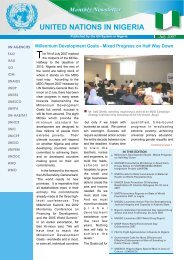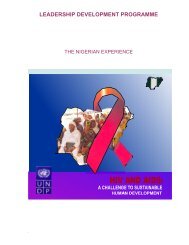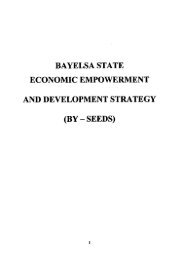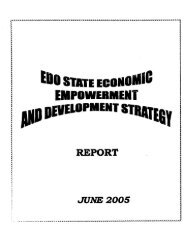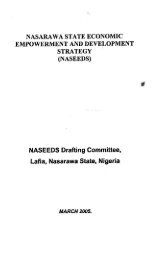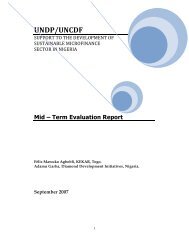Niger Delta Human Development Report - UNDP Nigeria - United ...
Niger Delta Human Development Report - UNDP Nigeria - United ...
Niger Delta Human Development Report - UNDP Nigeria - United ...
You also want an ePaper? Increase the reach of your titles
YUMPU automatically turns print PDFs into web optimized ePapers that Google loves.
CHAPTER<br />
TWO<br />
The <strong>Human</strong> <strong>Development</strong><br />
Situation in the <strong>Niger</strong> <strong>Delta</strong><br />
In line with the people-centred approach<br />
to development described in chapter one,<br />
this chapter uses several human<br />
development indices to assess the <strong>Niger</strong><br />
<strong>Delta</strong> region. The analysis highlights<br />
empirical deprivation overall, and outlines<br />
the disparities between different areas and<br />
socio-economic groups. It begins by<br />
depicting the nature, extent and spatial<br />
patterns of poverty and socio-economic<br />
deprivation, underscoring the dismal<br />
performance of governments at all levels<br />
in addressing critical human development<br />
needs.<br />
POVERTY IN THE NIGER DELTA<br />
The incidence of poverty in <strong>Niger</strong>ia has<br />
increased since 1980 (see table 2.1). According<br />
to the Federal Office of Statistics<br />
(1999), while poverty incidence was 28.1<br />
per cent in 1980, it rose to 46.3 per cent in<br />
1985. It declined slightly to 42.7 per cent<br />
in 1992, before soaring dramatically to 65.6<br />
per cent in 1996. Estimates from the Central<br />
Bank of <strong>Niger</strong>ia (1999) were even<br />
higher, with the Bank putting the overall<br />
poverty rate for the country at 69 per cent<br />
in 1997. Aigbokhan (1998), using the food<br />
energy intake measure, determined the incidence<br />
of national poverty as 38 per cent<br />
in 1985, 43 per cent in 1992 and 47 per<br />
cent in 1996. Evidence from the National<br />
Bureau of Statistics suggests that using the<br />
food energy intake measure yields a figure<br />
of 34.9 per cent in 2004. The relative<br />
poverty 1 trend reveals that the incidence<br />
rose from 28.1 per cent in 1980 to 46.3<br />
per cent in 1985, but declined to 42.7 per<br />
cent in 1992. It later rose to 65.6 per cent<br />
in 1996 before declining to 54.4 per cent<br />
in 2004 (National Bureau of Statistics<br />
2005).<br />
In the <strong>Niger</strong> <strong>Delta</strong>, the situation is similar<br />
to that at the national level. Except for<br />
Rivers and Bayelsa states, where poverty<br />
incidence seems to have stabilized at<br />
around 44 per cent after an initial jump<br />
from seven per cent, the poverty level increased<br />
between 1980 and 1996 (see table<br />
2.1). In line with the national estimate, poverty<br />
incidence declined between 1996 and<br />
2004. 2<br />
Table 2.1: Incidence of Poverty in the <strong>Niger</strong> <strong>Delta</strong>, 1980-2004<br />
1980 1985 1992 1996 2004<br />
<strong>Niger</strong>ia 28.1 46.3 42.7 65.6 54.4<br />
Edo/<strong>Delta</strong> 19.8 52.4 33.9 56.1 <strong>Delta</strong> 45.35<br />
Edo 33.09<br />
Cross River 10.2 41.9 45.5 66.9 41.61<br />
Imo/Abia 14.4 33.1 49.9 56.2 Imo 27.39<br />
Abia 22.27<br />
Ondo 24.9 47.3 46.6 71.6 42.15<br />
Rivers/Bayelsa 7.2 44.4 43.4 44.3 Rivers 29.09<br />
Bayelsa 19.98<br />
Source: National Bureau of Statistics 2004.<br />
1 Relative poverty refers to people living below two-thirds of the average weighted household income.<br />
NIGER DELTA HUMAN DEVELOPMENT REPORT<br />
A critical issue in the<br />
delta is not only the<br />
increasing incidence<br />
of poverty, but also<br />
the intense feeling<br />
among people that<br />
they ought to do far<br />
better given the<br />
enormous resources<br />
flowing from their<br />
region.<br />
High prices and the<br />
earnings of some<br />
workers tied to the oil<br />
industry erode the purchasing<br />
power of the<br />
ordinary person, making<br />
poverty more pervasive<br />
than conventional<br />
measurements<br />
reveal.<br />
35



